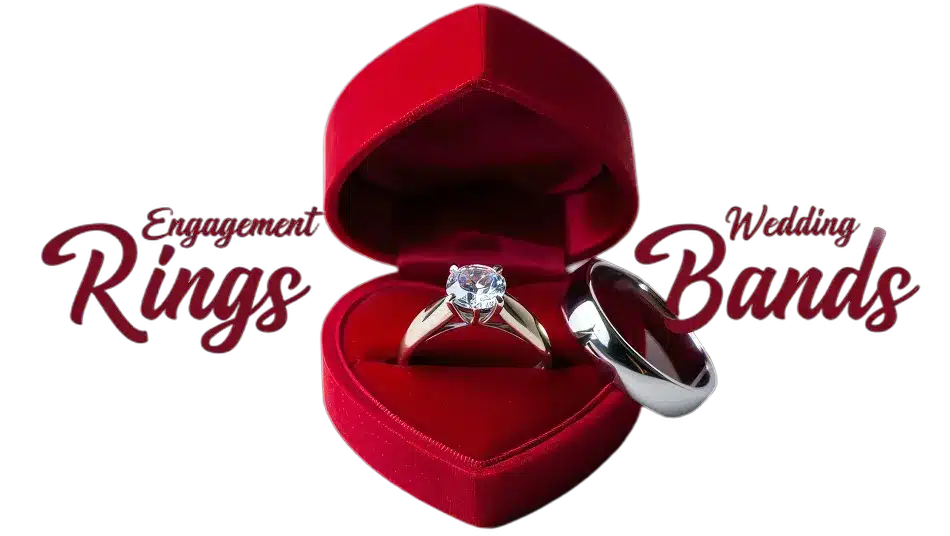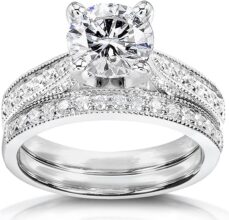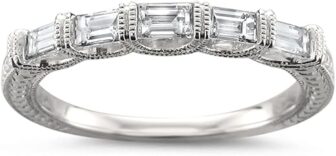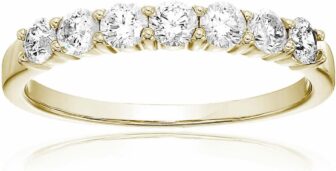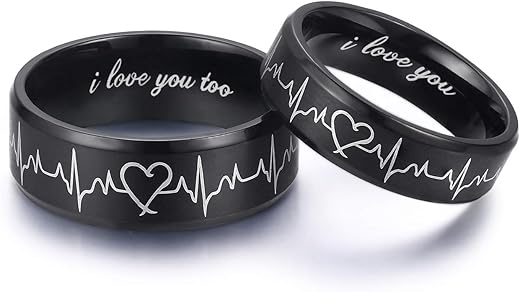
Unveiling the Symbolism of Wedding Bands
Have you ever pondered the significance behind wedding bands? These unassuming, circular pieces of metal carry profound meanings, rooted in history and tradition. As you step into this captivating journey, you’ll uncover the layers of commitment, love, and connection that each ring holds.
From their ancient beginnings in Egypt to the intricate designs seen today, wedding bands have evolved dramatically. This transformation mirrors societal changes, reflecting the values and customs of each era.
More than just beautiful jewelry, these rings symbolize an unbreakable bond between partners. As you explore this article, you’ll learn how wedding bands became a universal emblem of devotion across cultures and generations. Ready to delve into the rich tapestry of history and meaning? Let’s embark on this wonderful exploration together!




The Ancient Beginnings of Wedding Rings
As you embark on this journey through the history of wedding bands, it’s fascinating to consider their ancient origins. The very notion of a ring as a symbol of love and fidelity traces back thousands of years, to civilizations that sought to express deep emotional bonds through tangible objects.
Ancient Egypt: The First Symbols of Eternity
The earliest documented use of wedding rings appears in ancient Egypt around 3,000 BC. Egyptians believed that the circle represented eternity and had no beginning or end, making the ring an ideal token of love. Couples exchanged rings made from braided reeds or leather, signifying their commitment. This pride held in the ring’s circular shape continues to resonate today.
The Roman Influence
Fast forward a few centuries, and the Romans refined this symbol further. They favored bands made from iron, a material that signified strength and durability. The spouse wore the ring on the fourth finger of the left hand, which they believed contained the “vena amoris,” or the vein of love, directly leading to the heart.
Quick Fact: In ancient Rome, the wedding ring wasn’t just for the bride; it was a marker of ownership, highlighting the husband’s role in a patriarchal society.
The Rise of Gold and Precious Stones
As societies progressed, so did the materials used for wedding bands. By the Middle Ages, gold had emerged as the metal of choice, symbolizing wealth and status. Rings were adorned with gemstones that held unique meanings—like sapphires for fidelity and rubies for love. This artistic evolution represented the deepening significance of marriage as a partnership.
This transition to gold can be viewed as a reflection of the era’s romantic ideals, where love began to intertwine with social standing and economic stability. Couples would often choose rings featuring inscriptions or symbols that conveyed personal meanings, making their commitment even more special.
Customs Across Cultures
From ancient civilizations to different cultures, the exchange of rings is a universal practice. In many cultures, wedding bands were initially simple bands that evolved in design based on local materials and craftsmanship. Each society added its own flair—be it intricate carvings or engravings, each telling a story and solidifying the bond between partners.
As you uncover the deep historical roots of wedding rings in the next section, you’ll see how these early customs set the stage for the evolution of wedding bands through the ages. Ready to go further? Let’s delve into how these traditions changed and adapted over centuries!
The Evolution Through the Ages
As wedding bands aged like fine wine, their designs and meanings transformed, reflecting the shifting sands of societal norms, material innovations, and cultural insights. You might find it intriguing to see how styles that once echoed the modesty of ancient times morphed into the dazzling representations we see today.
The Renaissance: A Flourishing of Artistry
During the Renaissance, the wedding band witnessed an explosion of creativity. Metalworking techniques advanced, allowing for elaborate engraving and filigree work. Couples began opting for rings adorned with intricate designs or personal motifs, often featuring messages of love or symbols that represented their union. For instance, many rings bore the motto “Amor Vincit Omnia,” which translates to “Love conquers all.” These beautiful expressions of artistry not only marked a couple’s commitment but also showcased their social standing.
The Victorian Era: A Revival of Sentiment
The Victorian era brought a surge of romanticism that influenced wedding bands profoundly. This was when memento mori—rings that featured skulls or other reminders of mortality—became a popular aesthetic, reminding couples of the fleeting nature of life while celebrating the eternal bond of love. Additionally, the use of colored gemstones surged, with sapphires, emeralds, and garnets becoming popular for their unique meanings and beauty. This notion of love intertwined with sentiment became a hallmark of Victorian wedding bands.
The 20th Century: The Diamond Age
Fast forward to the 20th century, when diamonds exploded onto the scene, essentially transforming the wedding band into a symbol of luxury and everlasting love. Engagement and wedding rings became defined by their diamond center stones, driven in part by the now-famous De Beers campaign proclaiming that “A Diamond is Forever.” This was a period when the marriage of romance and economic status began to shape consumer habits, with couples willing to invest considerable sums in their rings, thereby elevating their status.
The Contemporary Shift: Personalization and Beyond
In recent years, the evolution of wedding bands has taken on a personal touch, as individuality reigns supreme. Customization is now the norm, allowing couples to create unique pieces that resonate deeply with their identity and values. From mixed metals to non-traditional stones and even alternative materials like wood or ceramic, couples are breaking the mold. Moreover, the rise of ethical consumerism has sparked interest in ethically sourced diamonds and lab-created gems, emphasizing values such as sustainability and social responsibility.
As you can see, the evolution of wedding bands mirrors not just cultural shifts but also the deepening significance of love and partnership itself. With each passing era, more ways to express commitment have emerged. Next, we’ll explore the rich symbolism woven into these rings—what exactly do they represent beyond their beautiful exteriors?
Symbolism and Meaning Behind the Ring
As you dive deeper into the world of wedding bands, you’ll uncover the profound symbolism that lies behind these circular tokens of love. At first glance, a wedding ring may just appear to be a beautiful piece of jewelry, but it encapsulates a wealth of meanings that resonate through time and cultures.
The Circle: A Symbol of Eternity
The first and foremost symbol associated with wedding bands is the circle. The endless shape denotes eternity, reminding you that love has no beginning or end. It’s a powerful representation that your commitment isn’t just a passing moment but a lifelong journey. Stories abound of couples who acknowledge this symbolism by choosing rings that reflect their unique bond—a couple might select a band that mirrors their love story, complete with engravings or shared symbols, making the circle even more meaningful.
Material Matters: Choosing the Right Metal
The choice of material further enriches the ring’s significance. Traditionally, gold dominated the landscape, symbolizing wealth, purity, and prosperity. However, modern couples are increasingly opting for alternatives that align with their values and preferences.
In this way, the choice of material encapsulates not just style but also the emotional resonance each partner brings to their union.
Personal Touches: Engravings and Gemstones
Adding personal touches can significantly enhance the symbolism of your wedding band. Many couples choose to engrave meaningful dates or quotes inside the band—this secret message serves as a constant reminder of their vows and shared journey. Additionally, the inclusion of gemstones can add layers of meaning:
For many, these choices reflect unique personal stories, allowing the rings to be artifacts of their love rather than mere pieces of jewelry.
The Journey Ahead
As you absorb the insights behind the symbolism of wedding rings, you may begin to appreciate how these elements contribute to the representation of eternal love and commitment. With understanding of these deeper meanings, you can explore more cultural variations and unique traditions surrounding wedding bands. Let’s delve into how diverse customs around the globe shape the way couples celebrate their unions!
The Modernization of Wedding Bands
As you embrace the rich history leading up to the modern era, it’s fascinating to see how contemporary wedding bands have emerged as a true canvas for personal expression. Today’s couples are more empowered than ever to bring their individual styles to the forefront, allowing their wedding bands to reflect their unique love stories.
Personalized Designs
Gone are the days when wedding bands conformed to a standard design. Today, personalization is at the heart of many couples’ choices. You may find stunning options like:
An example of this customization trend is the rise of stackable bands, which allow you to mix and match styles, metals, and even widths. The flexibility to change your ring configuration over time can represent your evolving journey as a couple.
Ethically Sourced Materials
In addition to design, the materials of wedding bands have also undergone a significant transformation. Many couples today prioritize sustainability and ethics in their purchases. You can expect to find:
This focus on ethical sourcing means your wedding ring can resonate with values important to you and your partner, marrying love and responsibility beautifully.
Celebrating Diversity
Moreover, contemporary wedding bands celebrate cultural diversity in a way that reflects global influences. Different communities are embracing traditional elements while incorporating modern flair. For instance, many couples choose to blend metals or feature traditional gemstones with contemporary designs that represent their heritage.
Engagement with various cultures can ensure a ring that not only signifies your bond but also honors the rich tapestry of backgrounds that shape relationships today.
The Future of Wedding Bands
As you explore the trends shaping modern wedding bands, it’s evident that personalization and conscious choices are key to the contemporary narrative. Couples today are not just selecting a ring; they are curating a piece that encapsulates their identities, beliefs, and dreams. As we shift into the next section, let’s uncover the diverse cultural variations and traditions that further enrich the significance of wedding bands around the world.
Cultural Variations and Traditions
Traveling across the globe, you’ll find that wedding bands evolve not only in design but also in meaning, shaped by cultural nuances and age-old traditions. Each society adds its unique flair to these timeless symbols of commitment, enriching the narrative of love and partnership.
Unique Cultural Practices
Across various cultures, wedding bands signify far more than just the union of two individuals. For example:
The Symbolism of Metals
The choice of metal can also represent cultural significance:
These materials often reflect local traditions, beliefs, and aesthetics, allowing couples to carry pieces of their heritage into their lives together.
Celebratory Rituals
It’s not just about the ring but also the accompanying rituals:
In Hawaii, the tradition of giving Hawaiian Heirloom Rings includes engravings in the Hawaiian language, celebrating the couple’s cultural bond. The engravings may symbolize love, family, and unity, drawing connections to shared values and histories.
Conclusion
As you navigate through these diverse cultural perspectives on wedding bands, it’s clear that each unique practice adds to the rich tapestry of love and commitment that transcends borders. You’re invited to consider how these traditions might resonate with your journey, leading us into the final reflections on the timeless appeal of wedding bands and the deep commitments they signify.
The Timeless Appeal of Wedding Bands
As you reflect on the journey through the history of wedding bands, you’ll appreciate the enduring nature of these symbols of love. From ancient rituals to modern designs, each ring tells a unique story, representing not only the union of two people but also the rich tapestry of cultural beliefs and traditions that surround marriage.
Whether you opt for a classic gold band or a contemporary piece with sparkling gemstones, your choice holds deep personal significance. Remember, it’s not just about the material but the love and commitment that it symbolizes. So as you embark on your own journey of love, consider the legacy of wedding bands and how your ring can embody your story for generations to come. Embrace the timeless appeal and let your band be a cherished reminder of your unique bond.
